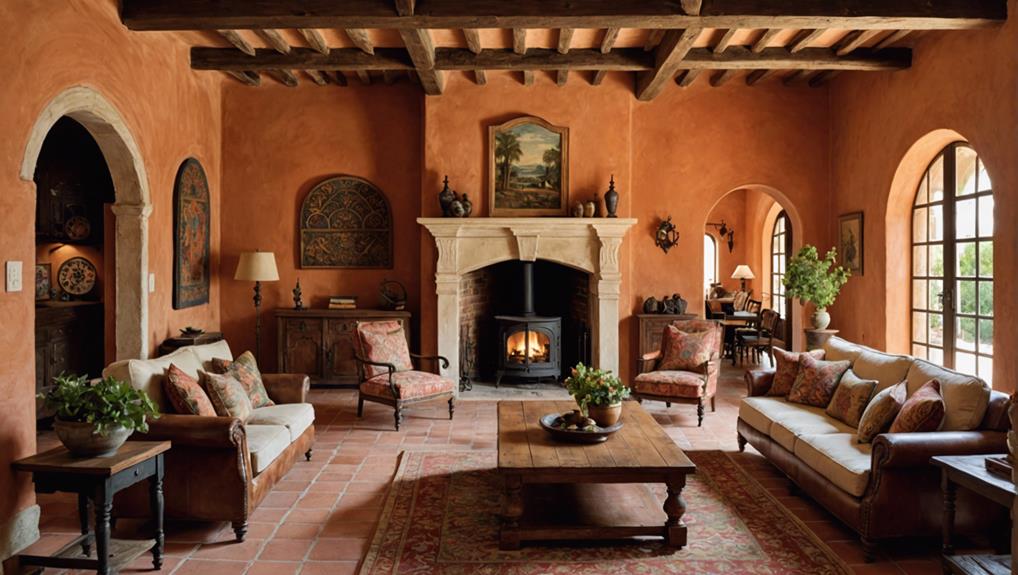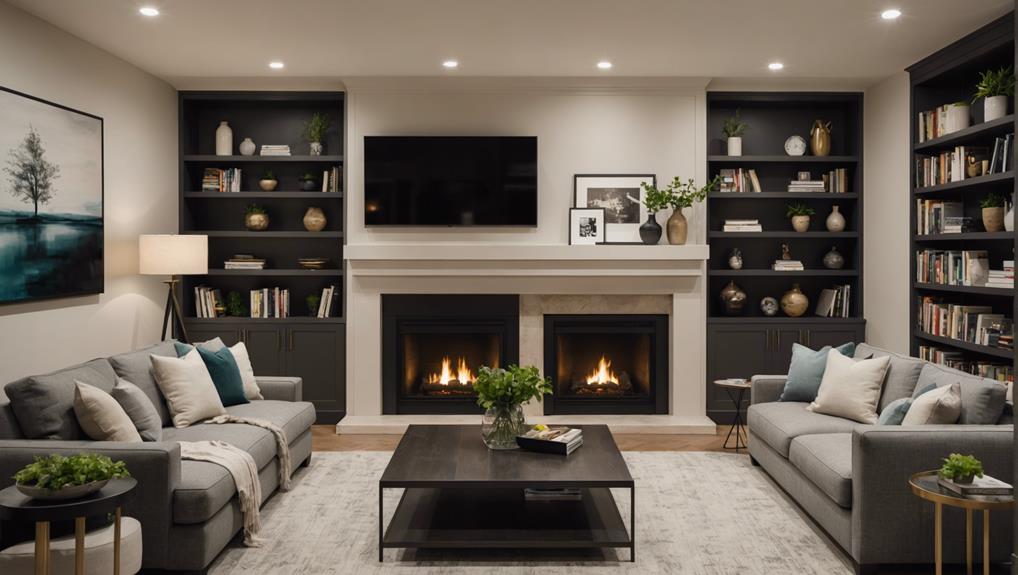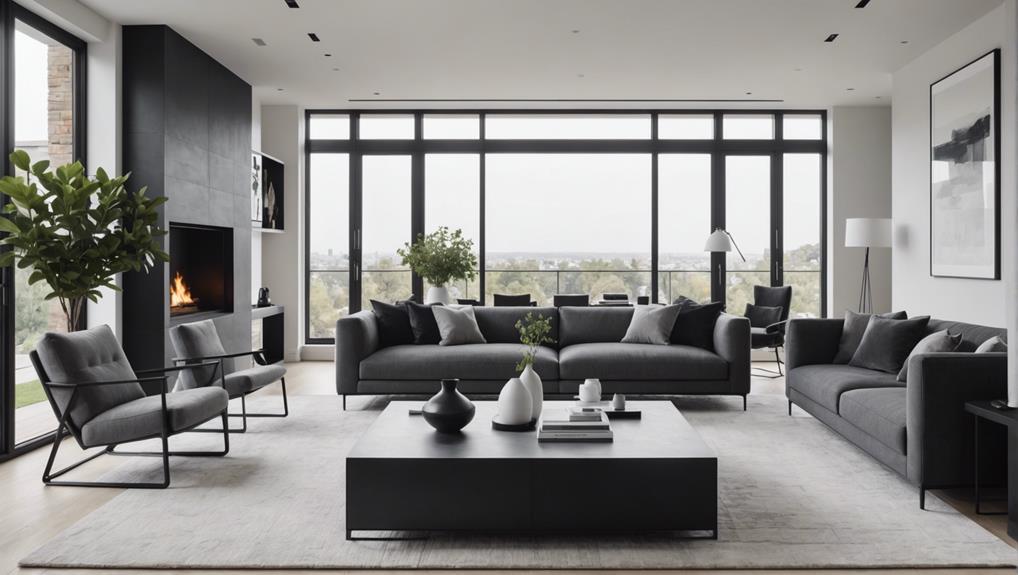
Designing a Spanish Colonial Living Room
Design a Spanish Colonial living room by emphasizing rustic wood features such as exposed beams and coffered ceilings. Integrate wrought iron elements through lighting fixtures, furniture, and decor accents. Use arched elements in doorways and windows to enhance the traditional architectural aesthetic. Achieve a stucco look with lime wash and chalk paint in warm, neutral tones for authentic texture. Incorporate Spanish tiles as fireplace surrounds or accent walls to infuse historical authenticity and visual interest. This combination of elements creates a cohesive, inviting space reflective of Spanish Colonial charm. Continue to explore these principles to master the design details.
Key Takeaways
- Emphasize rustic wood features with exposed beams and coffered ceilings.
- Incorporate wrought iron details in furniture, lighting fixtures, and wall art.
- Add arched doorways, windows, and design elements for authentic Spanish architectural flair.
- Achieve a stucco look using lime wash and chalk paint in warm, neutral tones.
- Integrate Talavera tiles for fireplace surrounds, accent walls, and tabletops.
Emphasizing Rustic Wood Features
To capture the essence of Spanish Colonial design, emphasize the natural allure of rustic wood features such as exposed beams and structural elements. Central to this architectural style are wood beam accents, which imbue a space with both structural integrity and aesthetic appeal. Exposed wood beams offer an authentic Spanish feel, evoking rustic charm through their natural beauty and grounding presence.
Incorporating wood beam accents within the ceiling structure, such as coffered ceilings, can greatly enhance the depth and architectural interest in the living room. This method not only adds visual intrigue but also creates a sense of cohesion and continuity throughout the space. Additionally, faux window headers made of wood can serve as subtle yet impactful design elements, further accentuating the Spanish Colonial ambiance.
When planning the layout and design, it is essential to integrate these wood features thoughtfully, ensuring they complement the overall aesthetic without overwhelming the space. The key is to allow the natural beauty of the wood to shine through, creating a harmonious blend of form and function. This approach guarantees that the living room exudes authentic Spanish charm while maintaining a warm and inviting atmosphere.
Incorporating Wrought Iron Details
Wrought iron details often act as quintessential elements that enhance the authenticity and elegance of Spanish Colonial living rooms. By integrating wrought iron accents into your space planning, you can achieve a harmonious blend of sophistication and timeless charm.
A well-curated selection of wrought iron elements can include a variety of pieces, from lighting fixtures to wall art, ensuring a cohesive aesthetic throughout the living room.
- Lighting Fixtures: Intricate chandeliers and simple wall sconces can serve as focal points, casting warm, ambient light that complements the Spanish Colonial style.
- Furniture Design: Incorporating wrought iron into furniture pieces, such as coffee tables or side tables, adds structural integrity and visual interest.
- Decor Accents: Items like wrought iron mirrors, candle holders, and curtain rods contribute to the overall cohesion and elegance of the interior.
- Wall Art: Wrought iron wall art can provide an artistic statement, bringing texture and depth to otherwise plain walls.
The versatility of wrought iron allows it to seamlessly blend with both traditional and modern Spanish Colonial design elements. Whether through intricate patterns or minimalist designs, wrought iron details can enhance the living space, making it a true reflection of Spanish Colonial heritage.
Adding Arched Design Elements
Incorporating arched design elements into a Spanish Colonial living room establishes an immediate sense of elegance and historical authenticity. Arched doorways, windows, and wall niches create a sense of grandeur, evoking traditional Spanish architectural flair. These elements enhance the overall aesthetic by capturing the essence of Spanish heritage and craftsmanship from the 1920s.
The use of archways seamlessly integrates the living room's various components, from the color palette to furniture selection. By incorporating soft curves and sweeping lines, the design evokes a harmonious blend of traditional and modern aesthetics. Arched windows invite natural light, complementing carefully chosen lighting fixtures to create a warm, inviting atmosphere.
| Design Aspect | Arched Element Impact |
|---|---|
| Color palette | Soft curves soften vibrant hues |
| Furniture selection | Enhances classic furniture silhouettes |
| Lighting fixtures | Highlights architectural nuances |
| Textile choices | Accentuates natural flow and texture |
| Space planning | Creates cohesive, visually appealing flow |
Textile choices, such as drapes and upholstery, should harmonize with the arched forms, enhancing the natural flow within the space. Additionally, strategic space planning ensures these architectural features are showcased effectively, accentuating the room's inherent beauty. Ultimately, arched design elements serve as a cornerstone in crafting an authentic and elegant Spanish Colonial living room.
Achieving the Stucco Look
Achieving the stucco look in a Spanish Colonial living room requires meticulous application techniques such as lime wash and chalk paint to create a textured, historically authentic finish. This approach enhances the depth and character of the walls, emulating the traditional stucco surfaces found in classic Spanish Colonial architecture.
To achieve this aesthetic, consider the following texture techniques and color choices:
- Lime Wash: This ancient method uses a lime-based mixture to create a soft, matte finish that lends an earthy, natural look to the walls.
- Chalk Paint: Ideal for adding a velvety texture, chalk paint can be layered and distressed to mimic the aged appearance of traditional stucco.
- Color Palette: Opt for warm, neutral tones such as ochre, terracotta, and beige to maintain the authenticity of the Spanish Colonial style.
- Layering Techniques: Combining different methods, like applying a base of lime wash followed by a top coat of chalk paint, can add complexity and depth to the finish.
Integrating stucco finishes into your living room design also involves strategic space planning. Consider how lighting effects can highlight the textured walls, and select furniture that complements the rustic, yet elegant atmosphere. By focusing on these elements, you can create a cohesive and inviting Spanish Colonial living room that feels both timeless and refined.
Integrating Spanish Tiles
Spanish tiles, such as the vibrant and intricately patterned Talavera tiles, serve as a quintessential design element that infuses a Spanish Colonial living room with historical authenticity and visual interest. These tiles, renowned for their colorful accents and traditional charm, can be strategically implemented to enhance the overall aesthetic of the space.
Incorporating Talavera tiles into the living room can be achieved through a variety of applications. Consider using these tiles as a striking fireplace surround, where their intricate patterns can create a visually stunning focal point. The artisanal craftsmanship of Talavera tiles not only adds depth and character but also introduces a timeless elegance that resonates with Spanish Colonial heritage.
Floors and walls provide additional surfaces to showcase these tiles. A tiled accent wall or floor section can break the monotony of larger surfaces, offering a dynamic contrast that enriches the room's design.
For a subtler approach, these tiles can be used as tabletops or as bordering elements around doorways and windows, seamlessly blending with the existing decor while adding a touch of traditional charm.
Frequently Asked Questions
What Is a Spanish Colonial Living Room?
A Spanish Colonial living room integrates a warm color palette with dark wood furniture and wrought iron accents. Furniture selection includes leather or velvet upholstery and hand-carved wooden pieces, enhancing the room's rustic yet elegant aesthetic.
How to Make Your Home Look Spanish Style?
To achieve a Spanish style, select a warm color palette with earthy tones and vibrant accents. Opt for rustic furniture choices, including wrought iron and wooden pieces, complemented by terracotta tiles and antique accessories for an authentic ambiance.
What Is Spanish Colonial Architecture Style?
Spanish Colonial architecture style, shaped by historical influence and regional variations, features stucco walls, terracotta roof tiles, and wrought iron detailing. Its space planning includes arched doorways and windows, courtyards, and intricate tile work.
What Is the Spanish Style of Interior Design?
The Spanish style of interior design emphasizes a warm, inviting color palette, traditional furniture, and intricate details. Characterized by stucco walls, terracotta tiles, and wrought iron accents, it blends vibrant colors with antique elements for a sophisticated ambiance.
Conclusion
To sum up, crafting a Spanish Colonial living room requires the careful integration of rustic wood features, wrought iron details, and arched design elements. This must be done while achieving the characteristic stucco look and incorporating Spanish tiles.
These components collectively establish an authentic and cohesive aesthetic that mirrors the heritage and architectural intricacies of Spanish Colonial design. Attention to these stylistic elements guarantees a space that is both historically resonant and functionally harmonious.



Leave a Reply